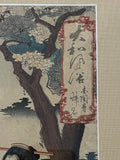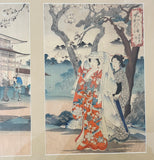Ukiyo e - Triptych
Kinkakuji Temple (Kyoto)
from the series
Customs and Manners of Yamato
1893
Chikanobu Toyohara 1838-1912 (also known as Chikanobu Yoshu) was a leading woodblock print artist of the Meiji Period. Born in Niigata prefecture as Naoyoshi Hashimoto, Chikanobu began his life as the son of samurai in the service of the Sakakibara clan. During the Meiji Restoration, he joined the shogitai, an elite samurai brigade in direct support of the waning Tokugawa Shogunate and fought bravely in the Battle of Ueno in 1868. Though captured in the fray, he was released unharmed. As the Shogunate fell, Chikanobu focused on a career in art.
Though trained in Kano school painting from an early age, Chikanobu shifted his attention to ukiyo-e around 1852. Chikanobu began his woodblock printmaking career under the tutelage of Utagawa School masters Kuniyoshi, Kunisada and Kunichika. Like many of his contemporaries, Chikanobu Toyohara worked as a newspaper illustrator as well as a print artist. By 1871, he had established himself as a leading print artist. He designed across all genres, from kabuki actors and beauties to military exploits of past and present. During the 1870s, Chikanobu captured Meiji Japan’s rapid modernization through kaika-e, or “enlightenment pictures.” Attuned to current events and public taste, he produced designs of both the 1877 Satsuma Rebellion, an ill-fated insurrection against the Meiji government, and well as the 1882 Imo Incident in Korea. Chikanobu’s reflected his changing world not only through his subject matter, but also in his materials. Incorporating the purples and reds of imported aniline dyes, he achieved an element of subtlety and sophistication rarely seen in his era. By the 1880s, a wave of national nostalgia for a Japan past prompted designs exploring traditional Japanese culture, values, and heroes. Through explorations of female beauty, Chikanobu Toyohara personified moments in Japanese history through fashion, manners and customs. In 1912, he died of stomach cancer.
Thank you for your interest in my curated selection of rare and unusual pieces! We have taken pride for over 20 years in our excellent reputation, and strive to satisfy our clients' exact needs. Please note that we take great care in accurately describing our items, and we support that with a money back guarantee. If you receive a product that is not as described, we will promptly refund the cost once the item has been returned in good order. If you have any questions or require further images/information in order to make a decision please do not hesitate to contact us.
Thanks and Best Regards,
David Dixon and the Strange Imports Team
strangeimports.com












